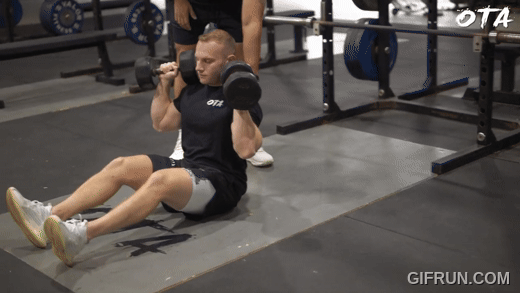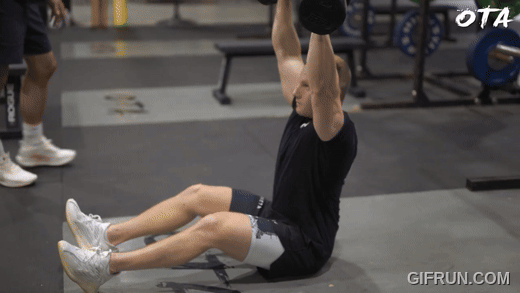How to Perform the Z Press: A Coach’s Step-by-Step Guide
The Z press, also known as the seated overhead press, is an excellent upper-body exercise that not only enhances vertical pressing power but also emphasizes core stability. Often used in phase one of athlete training, it builds a strong foundation for pressing movements by engaging the torso and improving posture. Whether you’re an athlete looking to enhance your overhead strength or a coach seeking a solid exercise to add to your training program, the Z press is an invaluable tool.
In this guide, we will walk you through the steps to perform the Z press correctly, discuss key setup points, explore variations with dumbbells and barbells, and provide coaching tips for effective performance.
Purpose and Benefits of the Z Press
The Z press is a seated overhead pressing movement that primarily targets the shoulders, triceps, and upper chest. However, unlike other overhead pressing exercises, the Z press forces you to engage the entire torso, including the core and lower back, to maintain an upright position. This added emphasis on core stability makes it a highly effective exercise for building overall strength and athletic performance.
The Z press is particularly useful during the first phase of training for athletes because it establishes a solid foundation for more complex movements and helps develop the ability to maintain a stable and rigid trunk under load. In addition to improving vertical pressing power, the Z press teaches athletes how to manage their posture and maintain body tension—both of which are critical for developing strength and avoiding injury in overhead movements.
Some key benefits of the Z press include:
- Improved vertical pressing strength: By pressing overhead while seated, the Z press helps athletes develop power for a variety of sports and activities.
- Enhanced core stability: The seated position forces the core to work hard, which helps with overall trunk stability in athletic performance.
- Better posture: As you perform the movement, you’re forced to stay tall and maintain a neutral spine, which can carry over to improved posture in daily life and other lifts.
- Increased focus on shoulder mechanics: With no back support, the Z press isolates the upper body, helping athletes work on proper shoulder alignment and scapular retraction.
Seated Position and Key Setup
The key to performing the Z press correctly starts with setting up in the proper seated position. This setup is critical not only for ensuring that the right muscles are engaged but also for minimizing the risk of injury.

1. Leg Positioning
To begin, sit on the floor with your legs straight out in front of you, keeping them about hip-width apart. It’s important that the legs remain straight, as bending them or widening them too much will reduce the engagement of your core and torso. Your toes should be pointing upward, and your feet should not be flat on the ground. Instead, your feet should hover just off the floor. This encourages proper trunk engagement by forcing the lower body to stabilize the upper body through the core.
2. Engaging the Trunk
When you’re in position, imagine a “hook” under your rib cage pulling your body upright. This mental cue will help you engage your core and ensure that your posture is tall and aligned. The goal is to create as much length in the torso as possible, ensuring the spine stays neutral and your chest is proud. To maintain this posture, you should feel tension in your entire core area. Additionally, keep your chin tucked slightly, and your tongue pressed to the roof of your mouth to maintain stability through the upper body.
3. Avoid Slouching
One of the biggest mistakes people make when performing the Z press is slouching or allowing their shoulders to round forward. If your trunk is not fully engaged, you risk losing stability during the press and making the movement less effective. Therefore, maintaining an upright, tall posture is crucial throughout the exercise.
Pressing Technique
Once you are in the correct position, it’s time to focus on the pressing movement itself. The Z press requires you to drive the weight overhead while maintaining a stable core and controlled posture. Here are the key technical points to focus on:

1. Start with the Weight at Shoulder Height
If you’re using dumbbells, you can start with them resting on your thighs and kick them up into position, one at a time. If you’re using a barbell, you’ll need to clean it into position or set it up on a rack so that it’s at shoulder height.
2. Drive the Weight Overhead
As you press the weight upward, focus on keeping your torso long and stable. Do not allow your chest to collapse or your back to arch excessively. The press should be controlled, with the weight traveling in a straight line directly overhead. Avoid leaning back or using your lower body for assistance—this is a strict upper-body press, and the challenge lies in maintaining total body tension while pushing the weight.
3. Elbow and Hand Positioning
One of the most important technical aspects of the Z press is the positioning of the elbows. Unlike the wide, flared elbows that are common in bodybuilding-style overhead presses, the Z press requires you to keep the elbows closer to your body. This positioning minimizes shoulder strain and maximizes core engagement.
For the most efficient and stable press, use a neutral grip with your elbows slightly forward and under the barbell or dumbbells. This will allow you to press the weight directly overhead without losing tension through your trunk. Focus on squeezing your glutes and bracing your core as you drive the weight upward.
4. Avoid Overextending the Lower Back
As you press the weight overhead, do not allow your lower back to overextend or your ribs to flare outward. This can lead to discomfort or injury. Maintain a neutral spine throughout the press, keeping your core tight and engaged to prevent any arching in the back.
5. Finish with the Head Through
As you clear your head with the weight, be sure to pull your head through the barbell (or dumbbell) path. This is a key part of the press, as it ensures the arms are fully extended, and the weight is directly overhead. At the top of the press, your elbows should be fully locked out, and the barbell (or dumbbells) should be in line with your body, directly over the shoulders.
Barbell and Dumbbell Variation
The technique for the Z press is similar whether you are using a barbell or dumbbells. However, there are a few differences that are worth noting:
- Dumbbells: Dumbbells allow for greater range of motion and can be a good option for athletes focusing on shoulder mobility and stability. Since the dumbbells move independently, they also allow for a more natural motion and may feel more comfortable for some lifters.
- Barbell: A barbell is often used in situations where the athlete is training for maximal strength or needs to push heavier weights. When performing the Z press with a barbell, ensure that the grip is about shoulder-width apart. This will provide a stable base for the press and help avoid excessive shoulder strain.
The key takeaway is that both variations emphasize strict vertical pressing and core engagement. Whether you use dumbbells or a barbell, maintaining good posture and proper technique is the most important factor in executing the Z press effectively.
Coaching Tips and Applications
As a coach, there are several key points you should focus on when teaching the Z press:
- Hand Positioning: On the barbell, make sure the grip is shoulder-width or slightly wider. Avoid going too wide, as this can create unnecessary stress on the shoulders and turn the press into more of a bodybuilding movement. A narrow grip also helps maintain core stability.
- Core Engagement: The Z press is all about maintaining trunk stability. Ensure that athletes are not overextending their lower backs and that they keep their core braced and engaged throughout the entire press.
- Avoid Flared Elbows: Keep the elbows in and slightly in front of the body. This neutral grip positioning allows for better scapular control and engages the torso more effectively.
- Press Vertically: The Z press should be performed with a strict vertical motion. Don’t allow the barbell or dumbbells to drift forward or backward. The movement should be controlled, and the weight should move directly upward from the shoulders.
- Dumbbells for Overhead-Focused Athletes: If you are training athletes who require overhead strength (e.g., Olympic lifters), using dumbbells can be ideal. However, for athletes involved in contact sports or other strength-based activities, barbells may be more appropriate for training maximal strength.
Conclusion
The Z press is an outstanding exercise for developing overhead strength and core stability. By performing this movement correctly, athletes can build a solid foundation for overhead pressing and improve overall posture and body tension. Whether using dumbbells or a barbell, the key to mastering the Z press is maintaining proper setup, pressing form, and torso engagement.
By incorporating the Z press into your training program, you’ll enhance both pressing power and trunk stability, providing a strong base for all of your athletic pursuits!

